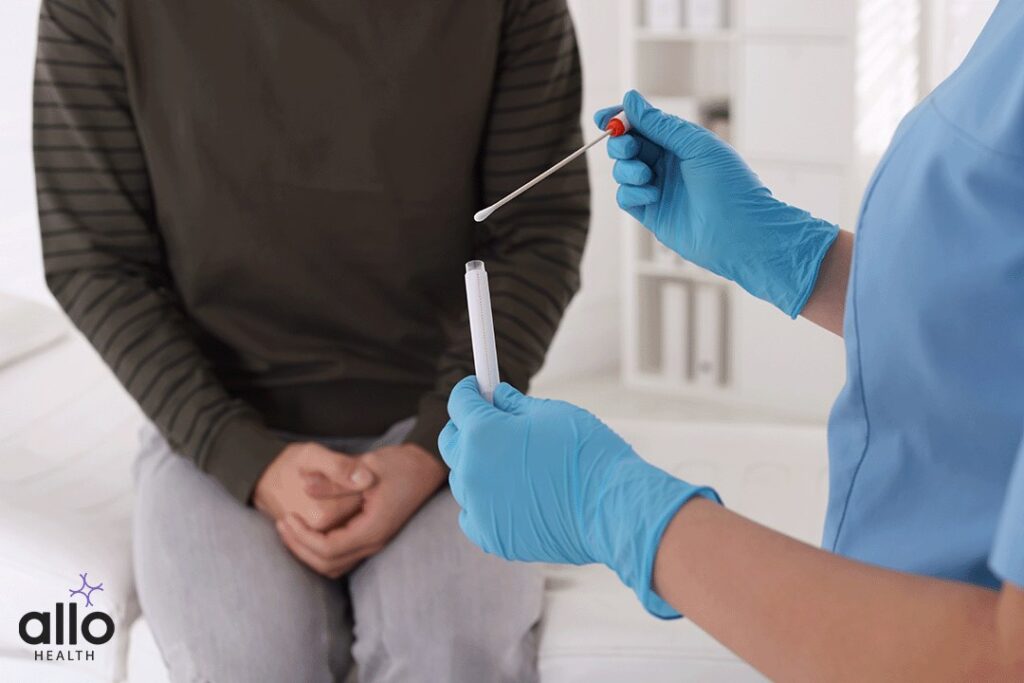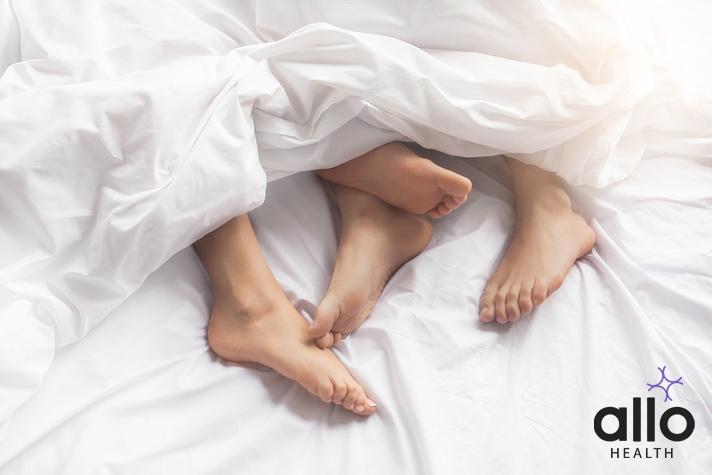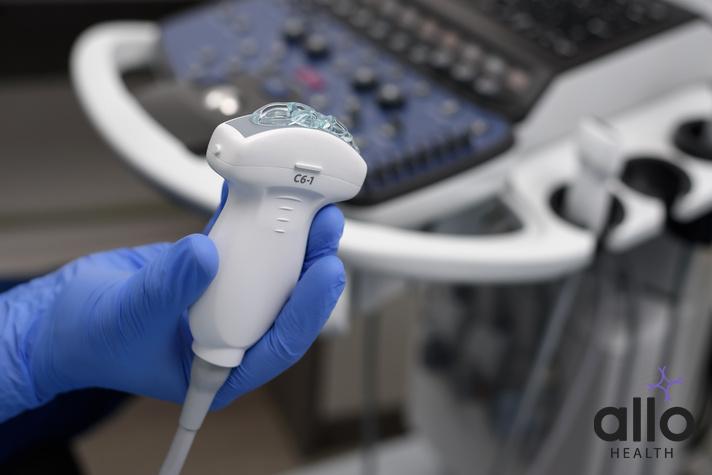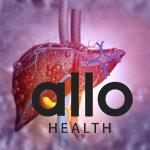Cyst from STDs: Causes, Symptoms, and Treatments

Allo Health is dedicated to personalized well-being, offering support and trusted information tailored to individual health goals. The platform emphasizes human-generated content, led by a distinguished medical team of experts, including physicians and sexual health specialists. Their commitment to credibility involves rigorous fact-checking, authoritative research, and continuous updates to ensure accurate, up-to-date information. Allo Health's unique approach goes beyond conventional platforms, providing expert-led insights and a continuous commitment to excellence, with user feedback playing a crucial role in shaping the platform's authoritative voice.

Dr. Aditi completed her undergraduate medical education at AJIMS, Mangalore, after which she worked in multi-speciality hospitals with COVID patients and in the Pain and Palliative medicine department. Driven by her experiences, she developed a keen interest in psychiatry. Dr. Aditi believes that mental health is just as, if not more important, than physical health.
Why This Was Upated?
Our experts continually monitor the health and wellness space, and we update our articles when new information became available.
Updated on 14 February, 2024
- Article was updated as part of our commitment to diversity, equity, and inclusion.

"The following blog article provides general information and insights on various topics. However, it is important to note that the information presented is not intended as professional advice in any specific field or area. The content of this blog is for general educational and informational purposes only.
Book consultation
The content should not be interpreted as endorsement, recommendation, or guarantee of any product, service, or information mentioned. Readers are solely responsible for the decisions and actions they take based on the information provided in this blog. It is essential to exercise individual judgment, critical thinking, and personal responsibility when applying or implementing any information or suggestions discussed in the blog."
Cysts from STDs, also known as sexually transmitted disease-related cysts, are fluid-filled growths that can develop in various genital areas as a result of bacterial or viral infections. These cysts can cause discomfort, pain, and other health issues. In this article, we will explore the different types of cysts associated with STDs, their causes, symptoms, and available treatments.
Can Someone Get Cysts from STDs?
- Yes, you can develop cysts from STDs, specifically bartholin cysts, penile cysts, and other genital cysts, due to bacterial or viral infections transmitted through sexual activity.
- These cysts may result from initial duct blockage, which can occur when sexually transmitted diseases like genital herpes lead to inflammation and infection in the genital area.
- Key risk factors for these cysts include poor personal hygiene, unprotected sexual contact, and underlying health conditions such as inflammatory diseases that weaken the immune system. Symptoms of STD-related cysts can include painful lumps, inflamed tissue, discomfort during sex, and even vaginal dryness.
- Diagnosis often involves a physical examination by a healthcare provider and may include swabbing for a sample of tissue or imaging tests.
- Treatment options include warm compresses, antibiotics for bacterial infections, surgical drainage, surgical removal for larger cysts, and over-the-counter pain relievers to manage discomfort and inflammation.
- Practicing safe sex, maintaining good hygiene, and regular medical check-ups can help reduce the risk of developing cysts from STDs.
Different Types of Cyst from STDs
There are several different types of cysts that can result from STDs, each with its unique characteristics and causes:
Bartholin Cysts:
- Bartholin cysts are common in women, often linked to bacterial infections, including STDs like genital herpes.
- They develop when the bartholin’s glands become blocked, resulting in a painful lump near the vaginal opening.
- Symptoms include discomfort during sex and pain, making everyday activities challenging.
- Warm water compresses can alleviate pain, but if the cyst becomes infected, antibiotics or surgical drainage may be required.
Penile Cysts:
- Men can also experience cysts on their genitalia, often due to STD-related bumps or infections.
- These cysts can cause discomfort and are typically linked to sexual activity.
- Surgical removal may be necessary for persistent or painful penile cysts.
Median Raphe Cyst:
- A less common cyst in men, developing along the median raphe on the underside of the penis.
- Typically asymptomatic, but they can lead to discomfort during sexual activity.
- Hygiene habits and sexual contact can influence their formation.
Epidermal Inclusion Cysts:
- These cysts result from blocked hair follicles and may be linked to STD-related infections.
- They often appear as small, movable lumps and can cause intense pain if infected.
- Warm compresses, antibiotics, or surgical removal are potential treatments.
Understanding these various types of cysts from STDs is crucial for early detection and appropriate management. Practicing safe sex, maintaining proper hygiene, and seeking medical advice are essential steps in preventing and addressing these cysts effectively.
Causes and Risk Factors of Cysts from STDs

- Sexual Contact: The primary cause of cysts from STDs is sexual contact with an infected partner. STDs such as genital herpes can lead to cyst formation in the genital area.
- Bacterial Infections: Many STDs are caused by bacterial infections, including chlamydia and gonorrhea. These infections can increase the risk of cyst development in the genital region.
- Poor Personal Hygiene: Inadequate hygiene habits can create an environment conducive to infection, increasing the risk of cysts. Proper hygiene is essential in preventing bacterial overgrowth.
- Weakened Immune Systems: Individuals with weakened immune systems, whether due to underlying health conditions or medication, are more susceptible to STD-related cysts.
- Inflammatory Diseases: Underlying inflammatory diseases can contribute to cyst formation. These conditions may create an environment where cysts are more likely to develop.
- Genital Herpes: This specific STD significantly elevates the risk of cysts in the genital area. The herpes virus can lead to painful cysts, especially in women (bartholin cysts).
- Sexual Activity: Engaging in sexual activity with multiple partners without protection can increase the likelihood of contracting STDs and subsequently developing cysts.
- Risk of Infection: Any behavior or condition that heightens the risk of contracting STDs, such as unprotected sexual intercourse or contact with STD carriers, can raise the risk of cyst formation.
Cysts from STDs are primarily caused by bacterial or viral infections resulting from unprotected sexual contact. Poor hygiene, weakened immune systems, and underlying inflammatory diseases can further increase the risk of cyst development. Understanding these causes and risk factors is crucial in preventing and managing cysts associated with STDs.
Symptoms and Diagnosis of Cysts from STDs

Symptoms:
- Painful Lumps: One of the most common symptoms of cysts from STDs is the presence of painful lumps in the genital area, such as bartholin cysts in women or penile cysts in men. These lumps may be uncomfortable and sensitive to the touch.
- Inflamed Tissue: STD-related cysts can lead to inflammation of the surrounding tissue. This inflammation can cause redness, swelling, and tenderness in the affected area.
- Discomfort During Sex: Cysts in the genital region can result in discomfort or pain during sexual activity. This can significantly impact a person’s sexual well-being and overall quality of life.
- Vaginal Dryness: In the case of bartholin cysts, women may experience vaginal dryness due to blocked glands, which can lead to discomfort and pain.
Diagnosis:
- Physical Examination: Health care providers typically start by conducting a physical examination of the affected area. They may palpate the cyst, assessing its size, location, and tenderness.
- Swab for Tissue Sample: To confirm the presence of an STD-related cyst, a swab may be taken from the affected area. This sample can be tested for the specific infection causing the cyst.
- Imaging Tests: In some cases, imaging tests such as ultrasounds or MRIs may be used to get a clearer picture of the cyst’s size and location.
- Medical History: Discussing the patient’s medical history, including any recent sexual activity and known risk factors for STDs, is essential in the diagnostic process.
Diagnosing cysts from STDs requires a combination of clinical evaluation, laboratory tests, and medical history assessment. Early diagnosis and prompt treatment are crucial to manage symptoms effectively and prevent complications.
Treatment Options
Treatment options for cysts from STDs vary depending on the type of cyst, its size, and the underlying STD infection. Here are the key treatment options:
Antibiotics:
- Antibiotics are often prescribed to treat cysts caused by bacterial infections, including those resulting from STDs like genital herpes or bacterial vaginosis.
- These medications target the underlying infection, reducing inflammation and the risk of further complications.
Surgical Drainage:
- In cases where the cyst becomes large or painful, surgical drainage may be necessary.
- This procedure involves puncturing the cyst and draining the accumulated fluid, relieving discomfort.
- Surgical drainage may also be performed to obtain a sample of tissue for further analysis if an STD is suspected.
Surgical Removal:
- Larger or persistent cysts may require surgical removal.
- This surgical procedure removes the entire cyst tissue, reducing the risk of recurrence.
- Surgical removal surgery can be performed on cysts located on the genitalia, including the penis or vulvar area.
Warm Compress:
- Applying a warm water compress to the cyst can help alleviate pain and discomfort.
- Warm compresses can be used in conjunction with other treatments to provide relief.
Pain Relievers:
- Over-the-counter pain relievers like ibuprofen or acetaminophen can be taken to manage pain and inflammation associated with cysts.
- These can be particularly helpful in reducing intense pain.
It’s essential to consult with healthcare providers for a proper diagnosis and personalized treatment plan. Additionally, practicing safe sex, maintaining good personal hygiene, and addressing underlying STDs are crucial steps in preventing future cyst formation and managing the risk of infection.
Preventing Cyst Formation
Preventing cyst formation from STDs is crucial for maintaining sexual health and overall well-being. By following these preventive measures, individuals can significantly reduce the risk of developing cysts associated with sexually transmitted diseases:
- Safe Sexual Activity: Always practice safe sex by using condoms or other barrier methods to minimize the risk of contracting STDs during sexual contact.
- Good Personal Hygiene: Maintain proper personal hygiene habits to reduce the risk of bacterial infections in the genital area. This includes regular cleaning with warm water and mild soap.
- Regular Check-ups: Schedule routine medical check-ups with healthcare providers to monitor and detect STDs early. Early detection can help prevent the development of cysts.
- STD Awareness: Educate yourself and your partner about STDs, their symptoms, and modes of transmission to make informed decisions about sexual activity.
- Responsible Sexual Behavior: Limit sexual contact to monogamous relationships or ensure that your partner is STD-free through testing.
- Protection During Contact Sports: If engaged in contact sports or activities where physical contact with the genital area may occur, use protective gear to prevent injuries that could lead to cyst formation.
- Prompt Treatment: If diagnosed with an STD, seek immediate medical attention and follow prescribed treatment regimens to prevent complications like cysts.
- Maintain a Healthy Lifestyle: A healthy diet and regular exercise can boost your immune system, reducing the risk of infection and cyst development.
By adopting these preventive measures and maintaining awareness of one’s sexual health, individuals can reduce the risk of cyst formation from STDs and enjoy a healthier and more comfortable life. Regular communication with healthcare providers and responsible sexual behavior are essential components of preventing cysts associated with sexually transmitted diseases.
Conclusion
Cysts from STDs can be a painful and uncomfortable aspect of a person’s health condition. It’s crucial to understand the causes, symptoms, and treatment options available. By practicing safe sex, maintaining proper hygiene, and seeking prompt medical attention, individuals can minimize the risk of cyst formation and enjoy a healthier and more comfortable life throughout their phases of life. Consulting with medical professionals is always recommended for the best care and guidance in managing these cysts.
Most Asked Questions
-
What causes cysts from STDs?
Cysts from STDs are usually caused by infections transmitted through sexual contact. Bacterial or viral infections, like genital herpes, can lead to cyst formation in the genital area.
-
What are the common symptoms of these cysts?
Common symptoms include painful lumps near the genital area, discomfort during sex, and inflammation. Vaginal dryness may also occur in women.
-
How can I prevent STD-related cysts?
Practicing safe sex by using protection and maintaining good personal hygiene habits can reduce the risk of developing these cysts. Regular medical check-ups help detect STDs early, lowering the risk of cyst formation.
-
What are the treatment options for STD-related cysts?
Treatment options include warm compresses to alleviate pain, antibiotics for cysts caused by bacterial infections, surgical drainage, and, in some cases, surgical removal for larger or persistent cysts. Over-the-counter pain relievers can also help manage discomfort. Consulting with a healthcare provider is crucial for proper care.






































